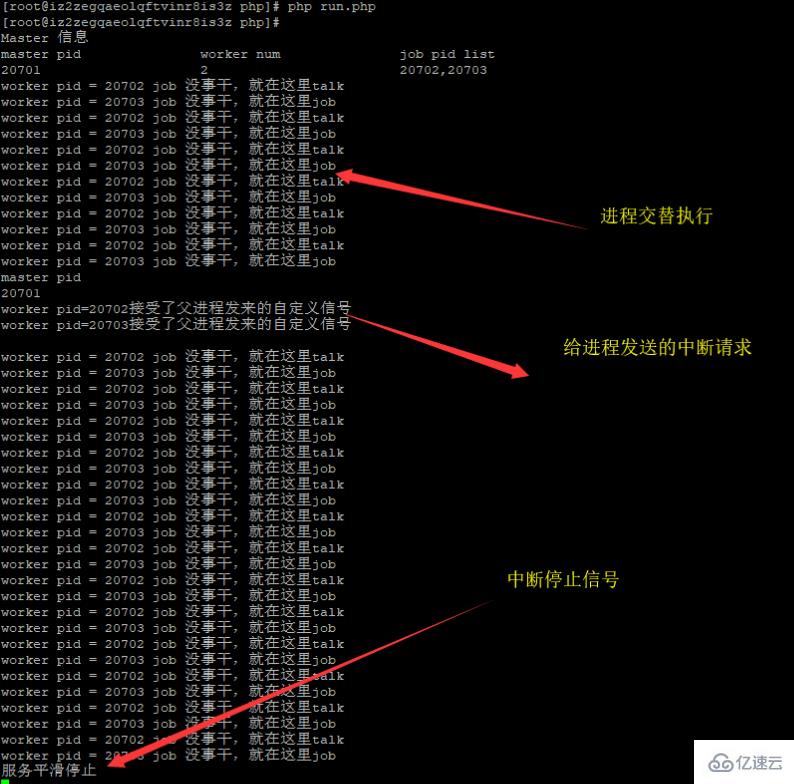这篇文章主要介绍PHP多进程与信号中断实现多任务常驻内存管理的示例分析,文中介绍的非常详细,具有一定的参考价值,感兴趣的小伙伴们一定要看完!
进程调度策略
父子进程的调度由操作系统来负责,具体先调度子进程还是父进程由系统的调度算法决定,当然可以在父进程加上延时或是调用进程回收函数 pcntl_wait 可以先让子进程先运行,进程回收的目的是释放进程创建时占用的内存空间,防止变成僵尸进程。
信号:
信号称为软中断系统或是叫软中断,功能是向进程发送异步事件通知。
信号编号: 【源码基于 SIGINT,SIGTERM,SIGUSR1 信号,含义请自行查看 kill 命令手册,不在描述】
linux 支持 64 个,有一半为实时信号,一半为非时实信号,这些信号都有自己的编号和对应的整数值。每个信号的编号含义读者可以参阅 linux 相关手册【man 手册看看就知道了】
信号处理函数:
信号一般会绑定相应的功能,有的是默认动作如 SIGKILL,SIGTERM,SIGINT 操作默认操作就是干掉进程,当然我们可以重写覆盖掉,就是通过 pcntl_signal 来覆盖掉。
信号的概念:与硬件中断一个道理,请读者自行参考本人前面撸过的文章或是查看芯片硬件中断原理。
信号的发送:
kill 信号编号 进程 或是按键产品的中断信号或是在源码里可以使用 posix_kill 等函数。
进程是相互隔离的,拥有自己的堆栈空间,除了一些公用的正文【代码区】,同时也有自己的可执行代码,进程运行时,将占用 cpu 的资源,其它进程将无权运行,此时其它进程将为阻塞状态【比如前面撸过的 tcp 服务】,当进程运行结束后【运行到代码的最后一句或是遇到 return 或是遇到 exit 退出进程函数或是遇到信号事件时将会退出】让出权限并释放掉内存,其它进程就有机会运行了。
进程拥有的自己进程描述符,其中比较常用的是进程号 PID,进程运行时会在系统 /proc/PID 下生成相应的进程文件,用户可以自行查看。
每个进程都拥有所属的进程组【进程的集合】,多个进程组集合则是一个会话,创建一个会话是通过一个进程进行创建的,并且此进程不可以为组长进程,此进程将成为会话期的会话首进程,也会成为进程组的进程组长,同时将会脱离控制终端,即使之前的进程绑定了控制终端也会脱离【守护进程的创建】。
文件描述权限掩码【权限屏蔽字】:
umask () 你可以在 linux 运行这个命令,然后创建文件,并查看它的权限【如果你跑完啥也没有发现,说明你还是训练不够 ^_^】
<?php
/**
* Created by PhpStorm.
* User: 1655664358@qq.com
* Date: 2018/3/26
* Time: 14:19
*/
namespace Chen\Worker;
class Server
{
public $workerPids = [];
public $workerJob = [];
public $master_pid_file = "master_pid";
public $state_file = "state_file.txt";
function run()
{
$this->daemon();
$this->worker();
$this->setMasterPid();
$this->installSignal();
$this->showState();
$this->wait();
}
function wait()
{
while (1){
pcntl_signal_dispatch();
$pid = pcntl_wait($status);
if ($pid>0){
unset($this->workerPids[$pid]);
}else{
if (count($this->workerPids)==0){
exit();
}
}
usleep(100000);
}
}
function showState()
{
$state = "\nMaster 信息\n";
$state.=str_pad("master pid",25);
$state.=str_pad("worker num",25);
$state.=str_pad("job pid list",10)."\n";
$state.=str_pad($this->getMasterPid(),25);
$state.=str_pad(count($this->workerPids),25);
$state.=str_pad(implode(",",array_keys($this->workerPids)),10);
echo $state.PHP_EOL;
}
function getMasterPid()
{
if (file_exists($this->master_pid_file)){
return file_get_contents($this->master_pid_file);
}else{
exit("服务未运行\n");
}
}
function setMasterPid()
{
$fp = fopen($this->master_pid_file,"w");
@fwrite($fp,posix_getpid());
@fclose($fp);
}
function daemon()
{
$pid = pcntl_fork();
if ($pid<0){
exit("fork进程失败\n");
}else if ($pid >0){
exit(0);
}else{
umask(0);
$sid = posix_setsid();
if ($sid<0){
exit("创建会话失败\n");
}
$pid = pcntl_fork();
if ($pid<0){
exit("进程创建失败\n");
}else if ($pid >0){
exit(0);
}
//可以关闭标准输入输出错误文件描述符【守护进程不需要】
}
}
function worker()
{
if (count($this->workerJob)==0)exit("没有工作任务\n");
foreach($this->workerJob as $job){
$pid = pcntl_fork();
if ($pid<0){
exit("工作进程创建失败\n");
}else if ($pid==0){
/***************子进程工作范围**********************/
//给子进程安装信号处理程序
$this->workerInstallSignal();
$start_time = time();
while (1){
pcntl_signal_dispatch();
if ((time()-$start_time)>=$job->job_run_time){
break;
}
$job->run(posix_getpid());
}
exit(0);//子进程运行完成后退出
/***************子进程工作范围**********************/
}else{
$this->workerPids[$pid] = $job;
}
}
}
function workerInstallSignal()
{
pcntl_signal(SIGUSR1,[__CLASS__,'workerHandleSignal'],false);
}
function workerHandleSignal($signal)
{
switch ($signal){
case SIGUSR1:
$state = "worker pid=".posix_getpid()."接受了父进程发来的自定义信号\n";
file_put_contents($this->state_file,$state,FILE_APPEND);
break;
}
}
function installSignal()
{
pcntl_signal(SIGINT,[__CLASS__,'handleMasterSignal'],false);
pcntl_signal(SIGTERM,[__CLASS__,'handleMasterSignal'],false);
pcntl_signal(SIGUSR1,[__CLASS__,'handleMasterSignal'],false);
}
function handleMasterSignal($signal)
{
switch ($signal){
case SIGINT:
//主进程接受到中断信号ctrl+c
foreach ($this->workerPids as $pid=>$worker){
posix_kill($pid,SIGINT);//向所有的子进程发出
}
exit("服务平滑停止\n");
break;
case SIGTERM://ctrl+z
foreach ($this->workerPids as $pid=>$worker){
posix_kill($pid,SIGKILL);//向所有的子进程发出
}
exit("服务停止\n");
break;
case SIGUSR1://用户自定义信号
if (file_exists($this->state_file)){
unlink($this->state_file);
}
foreach ($this->workerPids as $pid=>$worker){
posix_kill($pid,SIGUSR1);
}
$state = "master pid\n".$this->getMasterPid()."\n";
while(!file_exists($this->state_file)){
sleep(1);
}
$state.= file_get_contents($this->state_file);
echo $state.PHP_EOL;
break;
}
}
}
<?php
/**\
* Created by PhpStorm.\ * User: 1655664358@qq.com
* Date: 2018/3/26\ * Time: 14:37\ */\namespace Chen\Worker;
class Job
{
public $job_run_time = 3600;
function run($pid)
{\sleep(3);
echo "worker pid = $pid job 没事干,就在这里job\n";
}
}
<?php
/**
* Created by PhpStorm.\ * User: 1655664358@qq.com
* Date: 2018/3/26\ * Time: 14:37\ */\namespace Chen\Worker;
class Talk
{
public $job_run_time = 3600;
function run($pid)
{\sleep(3);
echo "worker pid = $pid job 没事干,就在这里talk\n";
}
}
<?php
/**
* Created by PhpStorm.\ * User: 1655664358@qq.com
* Date: 2018/3/26\ * Time: 15:45\ */
require_once 'vendor/autoload.php';
$process = new \Chen\Worker\Server();
$process->workerJob = [new \Chen\Worker\Talk(),new \Chen\Worker\Job()];
$process->run();
以上是“PHP多进程与信号中断实现多任务常驻内存管理的示例分析”这篇文章的所有内容,感谢各位的阅读!希望分享的内容对大家有帮助,更多相关知识,欢迎关注亿速云行业资讯频道!
免责声明:本站发布的内容(图片、视频和文字)以原创、转载和分享为主,文章观点不代表本网站立场,如果涉及侵权请联系站长邮箱:is@yisu.com进行举报,并提供相关证据,一经查实,将立刻删除涉嫌侵权内容。